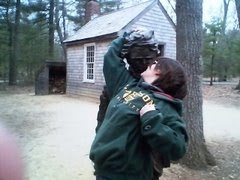
After reading the selected chapters in your anthology on Harriet Jacob's Incidents in the Life of a Slave Girl, consider the following questions about identity and hegemony.
1. How does “Linda’s” identity shift throughout the course of her life?
2. At what points in her life do consent and non-consent play a role in her identity development?
3. How does “Linda's” struggle with virtue and morality compare to Emerson’s exploration of virtue?
4. What super structural institutions play a role in defining virtue and morality, and how does “Linda’s” relationship to these institutions play a role in her self-identity?
5. Does her identity resolution become founded in notions of hegemony or counter-hegemony?
6. How do the ideals of Transcendentalism compare to Jacobs’ Incidents in the Life of a Slave Girl?

10 comments:
"Linda" growing up in an unjust world where conceptions of morality and virtues is distorted by prejudice and violence kept her in a constant struggle with what to believe is right or wrong... (to be contiued)
1.) Through out her story Linda shifted identities through her life, she basically went from a child,daughter/ grandaughter(1718) to a young slave(1719),to a lover(1721), to a lonely a desolate woman(1725), to a mother(1731) and a friend (1736). She change many of her identities as she grew older and she became to realize that she was a slave and that she wasn't free to live her own life.
-KEYLA HERNANDEZ
1.
The most important and obvious shift occurs when she first realizes she is a slave. Because she lived with other white children and was treated as their equal "Linda" never learned the socially accepted racial prejudices ruling over the world beyond her safe little house and protective grandmother. This shift shows the pointlessness and artificial quality of all racial sterotypes and prejudices in that if they are not taught, they don't exist.
In her shifts to both lover and to mother her dreams and hopes are smashed to bits. Her dreams of finding love and the happy life that she assumes would follow and not placing another human being in the terrible life she lives are foiled by the institution of slavery.
The shifts show that no matter who she becomes, mother, child, slave, or lover, slavery sticks to her like white on rice, like spots on dice, like hair on sheep. She can't escape it, slavery haunts her and continues to ruin her life until she finaly brakes free of it after years of bondage.
Kassie Doyle
2) Linda thinks she is happy but only becuase she doesn't know what true happiness is. She just thinks at least she's not being treated as bad as the other slaves, so she gives consent to do what her mistress and other masters want because she doesn't see anything wrong. It's like a hegemonic society. She shows non-consent when her mistress dies and she begans to explore love even though slaves aren't supposed to.
2) Linda thinks she is happy but only becuase she doesn't know what true happiness is. She just thinks at least she's not being treated as bad as the other slaves, so she gives consent to do what her mistress and other masters want because she doesn't see anything wrong. It's like a hegemonic society. She shows non-consent when her mistress dies and she begans to explore love even though slaves aren't supposed to.
RONNIE LEWIS
3) "Linda" growing up in an unjust world where conceptions of morality and virtues is distorted by prejudice and violence kept her in a constant struggle with what to believe is right or wrong. Linda experienced unwilling, at a young age, the horrors of human oppression. Emerson only through lifelong research was able to convey the results of his exploration of morals. Their experiences were different but through observing human activity they basically come to the conclusion that human society is morbidly corrupt in many aspects; that change was needed. Linda was born into slavery and experienced the butt of foul human demeanor.
Question 4.)
The structural institutions of slavery and of family play an important role in defining virtue and morality, having a strong influence of "Linda's" self-identity. Slavery has shaped her since childhood, and serves as a major aspect of her identity. The institution of it is very much a structure, as she is the subject of her masters. It shapes much of her outlook on the world and opinions.
She is also strongly influenced by her family. Though they are a poor family made up of slaves, "Linda" is very proud of them. She describes her father, a carpenter with much admiration. Their struggle through slavery and ability to overcome it serve as a strong factor in shaping the person she currently is now.
oh, ps. the comment above this is from kelly!
5. Does her identity resolution become founded in notions of hegemony or counter-hegemony?
At first while growing up, "Linda" was very much in a hegemonic type mind. She was young and naive. She believed in what people told her and did not try to break the system. On page 12 in the book "Linda" told her brother "Take courage, Willie; brighter days will come by and by," after their father dies. He is sick of slavery and wants out however "Linda" thinks there lives are fine and that they were basically meant to be slaves. When her brother was running away she told him, in attempt to make him stay, to go "and break your mother's heart" (21). (to be continued...)
the above comment was made by jewels
Post a Comment